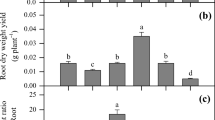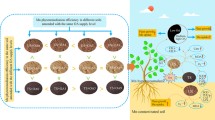Abstract
Up to date, very few studies have examined the phytoextraction ability of hyperaccumulators in the real soils contaminated with heavy metals following the identification of the hyperaccumulators using hydroponics tests. In the present study, amended with a chemical-mobilizing agent of ethylene diamine triacetic acid (EDTA), the manganese accumulation, tolerance and the hyperaccumulating ability of two hyperaccumulators Phytolacca americana L. (Phytolaccaceae) and Polygonum hydropiper L. (Polygonaceae) proved by previous hydroponics tests were examined using pot experiments with paddy soils contaminated with Mn (1,047 ± 53 mg kg−1) collected from one site in the vicinity of one manganese mine in Xiushan county of Chongqing, China. Results showed that the root and shoot biomass of P. americana and the chlorophyll production of P. hydropiper were significantly inhibited by EDTA treatments while the chlorophyll production of P. americana was oppositely obviously promoted by EDTA. It is noteworthy that, with or without EDTA treatment, the shoot Mn concentrations of both plant species were significantly below the hyperaccumulator threshold, indicating these two plants concealed their hyperaccumulating ability in the studied soils. Thus, further detailed studies need to be conducted to promote the metal hyperaccumulating capacity of these two plant species under comparably low Mn-contaminated soil conditions as shown in this study before the successful application of these Mn hyperaccumulators identified in laboratories to the phytoextraction of lightly or moderately Mn-contaminated agricultural soils.



Similar content being viewed by others
References
Baker AJM (1981) Accumulators and excluders—strategies in the response of plants to heavy metals. J Plant Nutrition 3(1–4):643–654
Baker AJM, Brooks RR (1989) Terrestrial higher plants which hyperaccumulate metallic elements—a review of their distribution, ecology and phytochemistry. Biorecovery 1:81–126
Baker AJM, McGrath SP, Sidoli CMD, Reeves RD (1994) The possibility of in situ heavy metal decontamination of polluted soils using crops of metal-accumulating plants. Resour Conserv Recy 11:41–49
Baker AJM, McGrath SP, Reeves RD, Smith JAC (2000) Metal hyperaccumulator plants: a review of the ecology and physiology of a biological resource for phytoremediation of metal-polluted soils. In: Terry N, Banuelos Q (eds) Phytoremediation of contaminated soil and water. Lewis, Boca Raton FL, pp 85–197
Baldisserotto C, Ferroni L, Anfuso E, Pagnoni A, Fasulo MP, Pancaldi S (2007) Responses of Trapa natans L. Floating laminae to high concentrations of manganese. Protoplasma 231:65–82
Barančiková G, Madaras M, Rybár Q (2004) Crop contamination by selected trace elements. J Soil Sediment 4:37–42
Chan DW, Son SC, Block W, Ye R, Douglas P, Pelley J, Goodarzi AA, Khanna KK, Wold MS, Taya Y, Lavin MF, Lees-Miller SP (2000) Purification and characterization of ATM from human placenta a manganese-dependent wortmannin-sensitive serine/threonine protein kinase. J Biol Chem 275:7803–7810
Chapman HD (1965) Cation exchange capacity. In: Black CA (ed) Methods of soil analysis, Part 2. American Society of Agronomy, Madison, pp 891–900
Chen H, Cutright T (2001) EDTA and HEDTA effects on Cd, Cr and Ni uptake by Helianthus annuus. Chemosphere 45:21–28
Chen HM, Zheng CR, Tu C, Zhu YG (1999) Heavy metal pollution in soils in China: status and counter-measures. Ambio 28:130–134
Deng H, Li MS, Chen YX (2009) Accumulating characteristics of manganese by Polygonum pubescens Blume. Acta Ecologica Sinica 29:5450–5454
Ding JQ, Reardon R, Wu Y, Zheng H, Fu WD (2006) Biological control of invasive plants through collaboration between China and the United States of America: a perspective. Biol Invasions 8:1439–1450
Dou CM, Chen XC, Shi JY, Chen YX (2010) Mn accumulation and detoxification in the root of hyperaccumulator Pokeweed. Acta Pedol Sin 47:168–171
Erikson KM, Aschner M (2003) Manganese neurotoxicity and glutamate GABA interaction. Neurochem Int 43:475–480
Gerber GB, Leonard A, Hantson P (2002) Carcinogenicity mutagenicity and teratogenicity of manganese compounds. Crit Rev Oncol Hema 42:25–34
Hammer D, Keller C (2003) Phytoextraction of Cd and Zn with Thlaspi caerulescens in field trials. Soil Use Manage 19:144–149
Hegedüs A, Erdei S, Horváth G (2001) Comparative studies of H2O2 detoxifying enzymes in green and greening barley seedlings under cadmium stress. Plant Sci 106:1085–1093
Huang JWW, Chen J, Berti WB, Cunningham SD (1997) Phytoremediation of lead-contaminated soils: role of synthetic chelates in lead phytoextraction. Environ Sci Technol 31:800–805
Hyatt LA, Araki S (2006) Comparative population dynamics of an invading species in its native and novel ranges. Biol Invasions 8:261–275
Kumar NPBA, Dushenkov V, Motto H, Raskin I (1995) Phytoextraction: the use of plants to remove heavy metals from soils. Environ Sci Technol 29:1232–1238
Lei YB, Chen K, Tian XR, Korpelainen H, Li CY (2007) Effect of Mn toxicity on morphological and physiological changes in two Populus cathayana populations originating from different habitats. Trees 21:569–580
Li XY, Zuo CS, Tschirley JB, Webb SE, Morton A (1997) Sustainable agriculture and rural development in China, Part 1: the agro-ecosystem and China’s rural economy. In: FAO/UNDP/Ministry of Agriculture, China Promotion of sustainable agriculture and rural development in China: elements for a policy framework and a National Agenda 21 Action Programme
Liphadzi MS, Kirkham MB, Mankin KR, Paulsen GM (2003) EDTA-assisted heavy-metal uptake by poplar and sunflower grown at a long-term sewage-sludge farm. Plant Soil 257:171–182
Liu P, Tang XM, Gong CF, Xu GD (2010) Manganese tolerance and accumulation in six Mn hyperaccumulators or accumulators. Plant Soil 335:385–395
Long XX, Yang X, Ye ZQ, Ni WZ, Shi WY (2002) Differences of uptake and accumulation of Zinc in four species of sedum. Acta Botanica Sinica 44:152–157
McGrath SP, Cunliffe CH (1985) A simplified method for the extraction of the metals Fe, Zn, Cu, Ni, Cd, Pb, Cr, Co and Mn from soils and sewage sludges. J Sci Food Agric 36:794–798
McGrath SP, Zhao FJ (2003) Phytoextraction of metals and metalloids from contaminated soils. Curr Opin Biotech 14:277–282
McGrath SP, Lombi E, Gray CW, Caille N, Dunham SJ, Zhao FJ (2006) Field evaluation of Cd and Zn phytoextraction potential by the hyperaccumulators Thlaspi caerulescens and Arabidopsis halleri. Environ Pollut 141:115–125
Memon AR, Aktoprakligil D, Özdemir A, Vertii A (2001) Heavy metal accumulation and detoxification mechanisms in plants. Turkey J Bot 25:111–121
Mertens J, Luyssaert S, Verheyen K (2005) Use and abuse of trace metal concentrations in plant tissue for biomonitoring and phytoextraction. Environ Pollut 138:1–4
Michael JB, Huang JW (2000) Phytoextraction of metals. In: Raskin I, Ensley BD (eds) Phytoremediation of toxic metals using plants to clean up the environment. Wiley, New York, pp 53–70
Ministry of Environmental Protection of P.R.China (MEP) (1990) The background values of China’s soils. Environmental Science Press, Beijing, pp 87–358
Nelson RE (1982) Carbonate and gypsum. In: Page AL (ed) Methods of soil analysis, Part 2. American Society of Agronomy, Madison, pp 181–199
Nelson DW, Sommers LE (1982) Total carbon, organic carbon, and organic matter. In: Page AL (ed) Methods of soil analysis, Part 2. American Society of Agronomy, Madison, pp 539–580
Nowack B, Schulin R, Robinson B (2006) Critical assessment of chelant-enhanced metal phytoextraction. Environ Sci Technol 40:5225–5232
Ren LM, Liu P, Cai MZ, Xu GD, Fang XY, Cheng ZX (2007) Physiological response of Polygonum hydropiper, Comnyza canadensis, Polygonum perfoliatum and Phytolacca americana to Manganese toxicity. Chinese J Soil Water Conserv 21:81–85
Salt DE, Blaylock M, Kumar NPBA, Dushenkov V, Ensley BD, Chet I, Raskin I (1995) Phytoremediation: a novel strategy for the removal of toxic metals from the environment using plants. Nat Biotechnol 13:468–474
Solhi M, Shareatmadari H, Hajabbasi MA (2005) Lead and zinc extraction potential of two common crop plants Helianthus annuus and Brassica napus. Water Air Soil Pollut 167:59–71
Steele MC, Pichtel J (1998) Ex-situ remediation of a metal-contaminated Superfund soil using selective extractants. J Environ Eng 124:639–645
Turgut C, Pepe MK, Cutright TJ (2004) The effect of EDTA and citric acid on phytoremediation of Cd Cr and Ni from soil using Helianthus annuus. Environ Pollut 131:147–154
Vartanian JP, Sala M, Henry M, Hobson SW, Meyerhans A (1999) Manganese cations increase the mutation rate of human immune deficiency virus type 1 ex vivo. J Gen Virol 80:1983–1986
Wang H, Tang SM, Liao XJ, Cao QM, Yang AF, Wang TZ (2007) A new manganese hyperaccumulator: polygonum hydropiper L. Chinese J Ecol Environ 16:830–834
Wei QH, Zhou HJ, Li WJ, He LN (2004) Studies on pharmacognosy of an Ethnodrug Polygonum hydropiper L. J Yunnan Coll Tradit Chinese Med 27:34–37
Wenzel WW, Unterbrunner R, Sommer P, Sacco P (2003) Chelate-assisted phytoextraction using canola (Brassica napus L) in outdoors pot and lysimeter experiments. Plant Soil 249:83–96
Wissemeier AH, Horst WJ (1992) Effect of light intensity on manganese toxicity symptoms and callose formation in cowpea (Vigna unguiculata). Plant Soil 143:299–309
Xue SG, Chen YX, Lin Q, Xu SY, Wang YP (2003) Phytolacca acinosa Roxb (Phytolaccaceae): a new manganese hyperaccumulator plant from Southern China. Acta Ecologica Sinica 23:935–937
Xue SG, Ye S, Zhou F, Tian SX, Wang J, Xu SY, Chen YX (2008) Identity of Phytolacca americana L. (Phytolaccaceae), Pokeweed: a manganese hyperaccumulator plant. Acta Ecologica Sinica 28:6344–6347
Yuan M, Tie BQ, Tang MZ, Isao A (2007) Accumulation and uptake of manganese in a hyperaccumulator Phytolacca americana. Mine Eng 20:188–190
Zhu CC, Zhang BY, Ye FL, Zhu GX, Yang JQ (1999) Effects of manganese exposure on male sexual hormone. China Pub Health 15:63–64
Zhuang P, Yang QW, Wang HB, Shu WS (2007) Phytoextraction of heavy metals by eight plant species in the field. Water Air Soil Pollut 184:235–242
Acknowledgments
The authors are greatly thankful to the reviewers for their constructive comments and detailed suggestions improving the present manuscript significantly. The authors also would like to thank the supports for this work from the Supporting Program of the “Twelfth Five-year Plan” for Sci & Tech Research of China (2011BAB09B01, 2012BAB05B03), National Natural Science Fund of China (40871222), Natural Science Foundation Project of Chongqing Sci & Tech Committee (CSTC 2009BA7029, 2006BB7424) and Science Foundation of Chongqing Educational Committee (KJ050410).
Author information
Authors and Affiliations
Corresponding author
Rights and permissions
About this article
Cite this article
Yang, Qw., Zeng, Q., Xiao, F. et al. Investigation of manganese tolerance and accumulation of two Mn hyperaccumulators Phytolacca americana L. and Polygonum hydropiper L. in the real Mn-contaminated soils near a manganese mine. Environ Earth Sci 68, 1127–1134 (2013). https://doi.org/10.1007/s12665-012-1814-9
Received:
Accepted:
Published:
Issue Date:
DOI: https://doi.org/10.1007/s12665-012-1814-9




